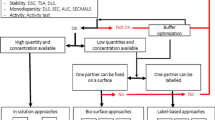Abstract
The WaterLOGSY (WL) and saturation transfer difference (STD) NMR experiments have proven to be extremely useful techniques to characterize interactions between small molecules and large biomolecules. In this work we compare the relative sensitivities of WL and STD NMR using 3 experimental systems: ketoprofen (KET)–bovine serum albumin (BSA), tert-butyl hydroquinone (TBHQ)–hemagglutinin (HA), and chloramphenicol (CAM)–ribosome (70S). In all cases we find that WL is more sensitive than STD for a given experimental time with the ratios ranging from 3.2 for KET–BSA to 16 for TBHQ–HA and CAM–70S. We attribute the increased sensitivity of WL to be due to simultaneous saturation of multiple sources of cross correlation, including direct NOEs of 1H of water and exchangeable groups and indirect NOEs of 1H–C groups. We suggest that the outstanding sensitivity of WL make it ideally suited for drug screening efforts targeting very large biomolecules at relatively low concentrations.





Similar content being viewed by others
References
Antanasijevic A, Cheng H, Wardrop D, Rong L, Caffrey M (2013) Inhibition of influenza H7 hemagglutinin-mediated entry. PLoS One 8:e76363
Assadi-Porter FM, Tonelli M, Maillet EL, Markley JL, Max M (2010) Interactions between the human sweet-sensing T1R2–T1R3 receptor and sweeteners detected by saturation transfer difference NMR spectroscopy. Biochim Biophys Acta 1798:82–86
Basu A, Antanasijevic A, Wang M, Li B, Mills D, Ames J, Moir DT, Prichard M, Barnard DL, Caffrey M, Rong L, Bowlin TL (2013) Novel inhibitors of influenza A virus fusion: interaction with the viral hemagglutinin. J Virol 88:1447–1460
Belova L, Tenson T, Xiong L, McNicholas PM, Mankin AS (2001) A novel site of antibiotic action in the ribosome: interaction of evernimicin with the large ribosomal subunit. Proc Natl Acad Sci USA 98:3726–3731
Bi S, Yan L, Sun Y, Zhang H (2010) Investigation of ketoprofen binding to human serum albumin by spectral methods. Spectrochim Acta A Mol Biomol Spectrosc 78:410–414
Carlomagno T (2005) Ligand–target interactions: what can we learn from NMR? Annu Rev Biophys Biomol Struct 34:245–266
Celigoy J, Ramirez B, Tao L, Rong L, Yan L, Feng YR, Quinnan GV, Broder CC, Caffrey M (2011) Probing the HIV gp120 envelope glycoprotein conformation by NMR. J Biol Chem 286:23975–23981
Cutting B, Shelke SV, Dragic Z, Wagner B, Gathje H, Kelm S, Ernst B (2007) Sensitivity enhancement in saturation transfer difference (STD) experiments through optimized excitation schemes. Magn Reson Chem 45:720–724
Dalvit C, Pevarello P, Tatò M, Veronesi M, Vulpetti A, Sundström M (2000) Time efficient detection of protein-ligand interactions with the polarization optimized PO-WaterLOGSY NMR experiment. J Biomol NMR 18:65–68
Dalvit C, Fogliatto G, Stewart A, Veronesi M, Stockman B (2001) WaterLOGSY as a method for primary NMR screening: practical aspects and range of applicability. J Biomol NMR 21:349–359
Delaglio F, Grzesiek S, Vuister GW, Zhu G, Pfeifer J, Bax A (1995) NMRPipe: a multidimensional spectral processing system based on UNIX pipes. J Biomol NMR 6:277–293
Gossert AD, Henry C, Blommers MJ, Jahnke W, Fernández C (2009) Time efficient detection of protein–ligand interactions with the polarization optimized PO-WaterLOGSY NMR experiment. J Biomol NMR 43:211–217
Harner MJ, Frank AO, Fesik SW (2013) Fragment-based drug discovery using NMR spectroscopy. J Biomol NMR 56:65–75
Ley NB, Rowe ML, Williamson RA, Howard MJ (2014) Optimising selective excitation pulses to maximize saturation transfer difference NMR spectroscopy. RSC Adv 4:7347–7351
Mamos P, Krokidis MG, Papadas A, Karahalios P, Starosta AL, Wilson DN, Kalpaxis DL, Dinos GP (2013) On the use of the antibiotic chloramphenicol to target polypeptide chain mimics to the ribosomal exit tunnel. Biochimie 95:1765–1772
Mayer M, James TL (2002) Detecting ligand binding to a small RNA target via saturation transfer difference NMR experiments in D2O and H2O. J Am Chem Soc 24:13376–13377
Mayer M, Meyer B (2001) Group epitope mapping by saturation transfer difference NMR to identify segments of a ligand in direct contact with a protein receptor. J Am Chem Soc 123:6108–6117
McCullough C, Wang M, Rong L, Caffrey M (2012) NMR characterization of influenza hemagglutinin receptor interactions. PLoS One 7:e33958
Rademacher C, Krishna NR, Palcic M, Parra F, Peters T (2008) NMR experiments reveal the molecular basis of receptor recognition by a calicivirus. J Am Chem Soc 130:3669–3675
Ramirez B, Antanasijevic A, Caffrey M (2014) Ligand screening using NMR. Methods Mol Biol 1140:305–313
Schlünzen F, Zarivach R, Harms J, Bashan A, Tocilj A, Albrecht R, Yonath A, Franceschi F (2001) Structural basis for the interaction of antibiotics with the peptidyl transferase centre in eubacteria. Nature 413:814–821
Shuker SB, Hajduk PJ, Meadows RP, Fesik SW (1996) Discovering high-affinity ligands for proteins: SAR by NMR. Science 274:1531–1534
Sowell J, Mason JC, Strekowski L, Patonay G (2001) Binding constant determination of drugs toward subdomain IIIA of human serum albumin by near-infrared dye-displacement capillary electrophoresis. Electrophoresis 22:2512–2517
Williamson MP (2009) Chapter 3 Applications of the NOE in molecular biology. In: Webb GA (ed) Annual reports on NMR spectroscopy, Vol 65. Academic Press, pp 77–109
Acknowledgments
The authors would like to gratefully thank Alexander Mankin for the kind gift of purified ribosome-70S. This work was supported by NIH Grant R21AI101676 and the UIC Research Resources Center and the Center for Structural Biology.
Author information
Authors and Affiliations
Corresponding author
Rights and permissions
About this article
Cite this article
Antanasijevic, A., Ramirez, B. & Caffrey, M. Comparison of the sensitivities of WaterLOGSY and saturation transfer difference NMR experiments. J Biomol NMR 60, 37–44 (2014). https://doi.org/10.1007/s10858-014-9848-9
Received:
Accepted:
Published:
Issue Date:
DOI: https://doi.org/10.1007/s10858-014-9848-9




